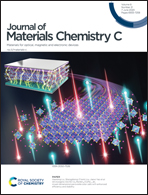Electric-controlled half-metallicity in magnetic van der Waals heterobilayer†
Abstract
Controlling the half-metallicity of 2D magnets is of great significance for both fundamental research and potential applications in quantum information storage, transmission and processing. Among the possible 2D magnetic heterostructures, those with intrinsic magneto-electric coupling have a great potential in this field. Herein we theoretically investigate the experimentally feasible CrI3–CrGeTe3 heterobilayers (Cr–H) and show electric-field-dependent half-metallicity. Besides the stacking-dependent magnetization in Cr–H, robust half-metallicity can be induced in ferromagnetic and ferrimagnetic heterobilayers by an electric field over 0.6 V Å−1. This is due to the electric-controlled band alignment in such asymmetric band structure. Furthermore, a spin-polarized band crossing is introduced in its type-II spin channel for a continuously increased electric field. Thus, the magnetic heterobilayer (e.g. Cr–H) with spin-polarized band alignment represents a promising materials platform for the design of 2D controllable magnetoelectronic and spintronic devices.

- This article is part of the themed collection: 2020 Journal of Materials Chemistry C most popular articles


 Please wait while we load your content...
Please wait while we load your content...